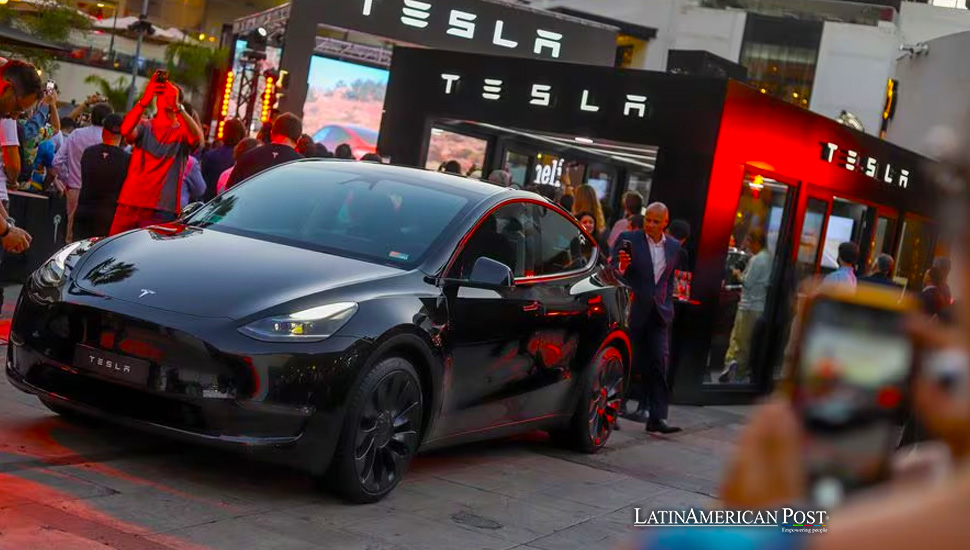Tesla’s Inaugural South American Store Opens Amid EV Market Challenges in Chile

This week, Tesla ventured into South America with its first store in Santiago, Chile, showcasing its electric vehicles in an upscale mall. Amid a global slowdown in EV demand and rising competition from Chinese manufacturers, the store’s opening marks a significant step for Tesla in a region with modest EV adoption, ambitious electric vehicle goals, and vast lithium reserves
Tesla’s South American Debut
In a bold move that underscores its global ambitions, Tesla has launched its first store in South America, choosing the vibrant city of Santiago, Chile, as the gateway for its sleek electric vehicles (EVs) to the continent. Nestled in an upscale mall, this venture comes at a time when the automotive giant, led by visionary CEO Elon Musk, navigates through the turbid waters of a global EV demand slowdown and stiffening competition from Chinese rivals.
While Tesla has established a retail footprint in Mexico, its foray into South America marks a new chapter in its expansion narrative. The Santiago store’s unveiling is not just a testament to Tesla’s global brand allure but also signals the growing importance of Latin America in the global EV landscape.
With its ambitious target to phase out combustion engine vehicles by 2035, Chile stands at the forefront of Latin America’s electric mobility revolution. However, the region grapples with low EV adoption rates, which are attributed to high vehicle costs and an embryonic charging infrastructure. Tesla’s entry into this market is both a challenge and an opportunity—a chance to catalyze a shift toward sustainable transportation in a region ripe for transformation.
Enthusiastic Unveiling in Santiago
The launch event at the new Santiago store attracted a crowd of enthusiasts and curious onlookers eager to witness firsthand the vehicles that have captured the imagination of millions worldwide. Among them was Noemi Schuffeneger, who, like many others, was drawn to the allure of Tesla’s Model Y and Model 3. “Seeing it here in person is so exciting,” Schuffeneger remarked, reflecting the sentiment of many who view Tesla’s vehicles as more than just cars but as emblems of innovation and sustainability.
Tesla staff were on hand to showcase the unique features of these electric marvels, from their renowned autopilot capabilities to the unconventional air conditioning system—a nod to Tesla’s penchant for redefining automotive norms.
The company’s strategic entry into South America was preluded by its business registration in Chile in September, signaling its intentions to sell vehicles and engage in the import, export, manufacturing, marketing, and distribution of EVs. This move aligns with Tesla’s broader vision of leading the transition to sustainable energy, encompassing the generation and supply of energy and electricity.
Chile’s Significance in the Global EV Narrative
Chile’s significance in the global EV narrative extends beyond its market potential. The country is home to one of the world’s largest lithium reserves, a critical ingredient in the batteries that power electric vehicles. Therefore, Tesla’s presence in Chile could herald a deeper involvement in the lithium supply chain, essential for the company’s long-term strategy to secure raw materials for its battery production.
However, Tesla’s South American venture has its challenges. The region’s nascent EV market is characterized by consumer skepticism, driven by concerns over vehicle affordability and the scarcity of charging stations. Overcoming these obstacles requires innovative technology and a concerted effort to build infrastructure and foster regulatory environments conducive to electric mobility.
Moreover, Tesla’s expansion came when the company faced increasing competition from Chinese EV manufacturers, rapidly gaining ground in global markets with their competitively priced models. These dynamics underscore the strategic importance of Tesla’s move into South America—a bid to capture market share in a region that could be pivotal in the global shift towards electric vehicles.
Tesla’s Blueprint for Regional Expansion
As Tesla charts its course in South America, the company’s initiatives in Chile could serve as a blueprint for expansion into other Latin American markets. Success in Chile could catalyze further regional investments, from establishing additional stores to exploring lithium extraction and battery production partnerships.
The significance of Tesla’s foray into South America extends beyond the automotive industry. It represents a broader shift towards sustainability, highlighting the critical role of innovation, technology, and strategic partnerships in addressing the global challenge of climate change. Tesla’s presence in Chile is not just about selling cars; it’s about promoting a vision of a cleaner, more sustainable future powered by electric mobility.
In this context, Tesla’s Santiago store is more than a retail outlet; it symbolizes the potential for electric vehicles to transform transportation in South America and beyond. It’s a beacon for environmental sustainability, showcasing the possibilities that arise when technology, ambition, and policy align toward a common goal.
Navigating Challenges, Embracing Opportunities
The journey ahead for Tesla in South America is fraught with challenges, from navigating regulatory landscapes to building consumer trust and infrastructure. Yet, the opportunities are vast. The region’s rich lithium reserves and growing awareness of environmental issues provide a fertile ground for Tesla to grow its brand and contribute to the global transition to sustainable energy.
The world is keenly watching as Tesla takes its first steps in South America. Will Tesla’s blend of innovation, luxury, and sustainability resonate with Latin American consumers? Can the company overcome the hurdles of high prices and limited infrastructure to drive EV adoption in the region? And perhaps most importantly, will Tesla’s presence in Chile spark a broader movement towards electric mobility in Latin America?
Also read: New Historical Documents That Confirm the Peruvian Origin of Pisco
Only time will tell, but for now, Tesla’s South American store opening marks a significant milestone in the company’s global journey. It’s a bold statement of Tesla’s commitment to leading the electric revolution, not just in established markets but in new frontiers with immense potential for impact. As Tesla navigates the complexities of the South American market, its efforts could accelerate the region’s journey toward a sustainable, electric-powered future.




